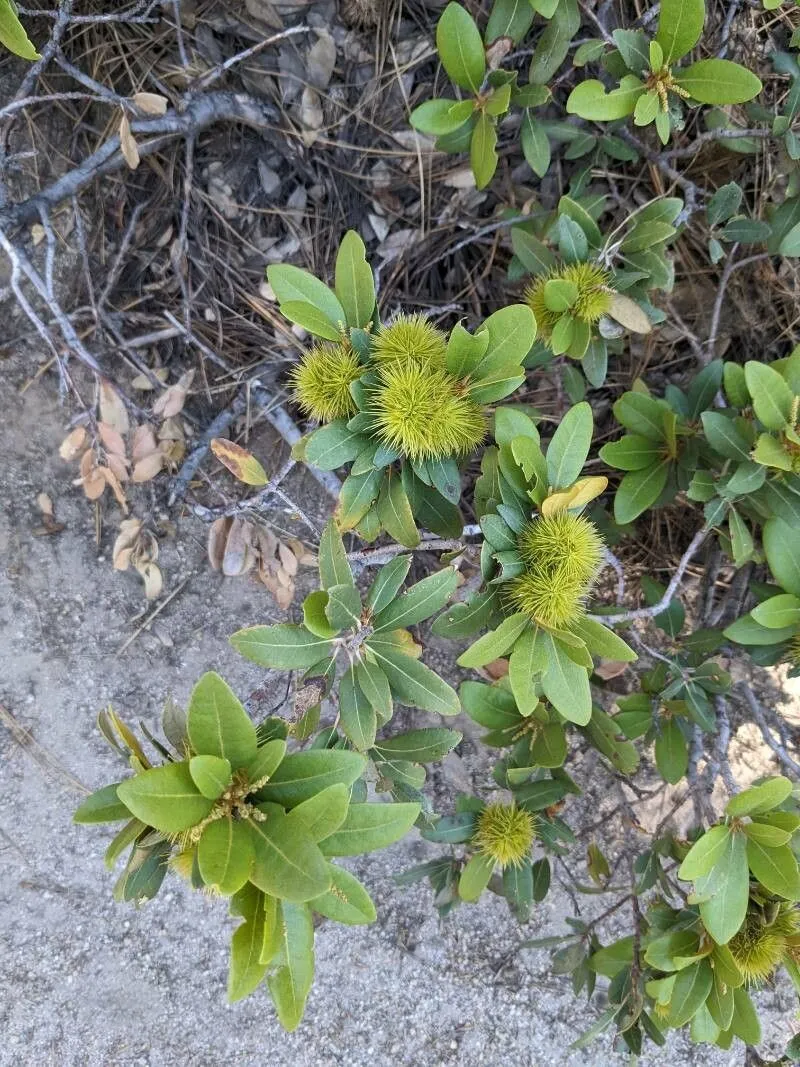
Author: (Kellogg) Hjelmq.
Bibliography: Bot. Not. 113: 377 (1960)
Year: 1960
Status: accepted
Rank: species
Genus: Chrysolepis
Vegetable: False
Observations: S. Oregon, California (Mts.)
Bush chinquapin, scientifically known as Chrysolepis sempervirens, is a prominent member of the Fagaceae family, a group that includes oaks and beeches. This versatile and resilient plant is observed primarily in the mountainous regions of Southern Oregon and California.
The bush chinquapin is a hardy evergreen shrub or small tree that is well-adapted to its native range’s challenging environments. This plant is noted for its dense, leathery leaves that exhibit a striking dark green hue on the upper side, while the underside reveals a contrasting golden or silvery tone, a characteristic that adds to its visual appeal. The presence of these dual-toned leaves is also a functional adaptation, serving to minimize water loss and reflect excess sunlight, which are crucial for its survival in the arid, sun-soaked terrains of the mountains.
Chrysolepis sempervirens produces inconspicuous flowers, yet it is recognized for its unique fruit – the chinquapin nuts. These nuts develop within spiny burrs, offering protection until they mature and open to release the seeds. These nuts, although not commonly consumed due to their bitter taste, were historically utilized by indigenous peoples for their nutritional value.
The authority on the current botanical nomenclature for this plant was established in “Botanical Notations” in 1960, attributed to the work of Hjelmq., following the initial description by Kellogg. This classification underscores the bush chinquapin’s standing within botanical circles and its significance in ecological studies.
Given its robust nature and the beauty it brings to the landscapes of Southern Oregon and California, the bush chinquapin is an excellent subject for those interested in native plant species and their adaptations to mountainous climates. The plant serves not only as a significant ecological component in its natural habitat but also as an aesthetic addition to gardens and natural preserves aiming to cultivate native flora.
Eng: sierra chinkapin, bush chinquapin, bush golden chinquapin
En: Bush chinquapin, Bush golden chinquapin, Sierra chinkapin
Taken Jul 8, 2022 by Barb T (cc-by-sa)
Taken Jul 8, 2022 by Barb T (cc-by-sa)
Taken Oct 15, 1998 by EOL − Charles Webber (cc-by-nc-sa)
Taken Mar 9, 2009 by EOL − Keir Morse (cc-by-nc-sa)
Taken Sep 11, 2014 by EOL − James Gonsman (public)
Taken Dec 2, 2015 by EOL − Keir Morse (cc-by-nc-sa)
Taken Oct 16, 1998 by EOL − Charles Webber (cc-by-nc-sa)
Taken Feb 18, 2011 by EOL − Wynn Anderson (cc-by-nc-sa)
Taken Mar 9, 2009 by EOL − Keir Morse (cc-by-nc-sa)
Taken Dec 2, 2015 by EOL − Keir Morse (cc-by-nc-sa)
Taken May 30, 2015 by EOL − Barry Breckling (cc-by-nc-sa)
Taken Oct 15, 1998 by EOL − Charles Webber (cc-by-nc-sa)
Growth form>: Multiple Stem
Growth habit>: Shrub
Growth rate>: Slow
Ph maximum: 7.0
Ph minimum: 5.0
Family: Myrtaceae Author: (F.Muell.) K.D.Hill & L.A.S.Johnson Bibliography: Telopea 6: 402 (1995) Year: 1995 Status:…
Family: Rubiaceae Author: Pierre ex A.Froehner Bibliography: Notizbl. Bot. Gart. Berlin-Dahlem 1: 237 (1897) Year:…
Family: Sapindaceae Author: Koidz. Bibliography: J. Coll. Sci. Imp. Univ. Tokyo 32(1): 38 (1911) Year:…
Family: Asteraceae Author: A.Gray Bibliography: Pacif. Railr. Rep.: 107 (1857) Year: 1857 Status: accepted Rank:…
Family: Fabaceae Author: Medik. Bibliography: Vorles. Churpfälz. Phys.-Ökon. Ges. 2: 398 (1787) Year: 1787 Status:…
Family: Aspleniaceae Author: (Cav.) Alston Bibliography: Bull. Misc. Inform. Kew 1932: 309 (1932) Year: 1932…